ABSTRACT
The study examined the effect of climatic variability on climatic water balance over Sudan Savannah, Nigeria. Temperature and Rainfall data were collected for the period 1943-2012 from the Nigerian Meteorological Agency. The data were divided into two climatic years 1943-1977 and 1978-2012. On the whole, rainfall amount decreased from a very high mean value of 981.5 mm in Yelwa (Lat. 10.88 N; Long. 4.75 E) to a very low value of 656.1mm in Katsina (Lat. 13.02 N; Long.7.68 E). This pattern reveals gradual/potential extension of dryness from the Lake Chad area in Nigeria in northeast, towards the Sudan savannah, northwest of Nigeria. Annual temperature, PET, moisture deficit distributions revealed very strong evidence of upward trend at α<0.01 with corresponding decrease in rainfall in the second climatic period, an indication of changing climate. However, in Yelwa, Sokoto and Gusau, there was little evidences of significant downward trend in annual rainfall distribution at α =0.10, but rather a quasi–periodic pattern, even though there were signs of statistical rise in temperature. The general pattern of deviation in PET from the first climate period were 1.4, 3.7, 2.7, 1.9% for Yelwa, Sokoto, Gusau and Katsina respectively, while moisture deficits were 5.0, 4.2, 4.0 and 7.9% for Yelwa, Sokoto, Gusau and Katsina respectively. This general observation may suggest that water balance parameters during the second climatic period deviated from patterns Observed in the first climatic period (1943-1977). Repetition of drought within the present climate regime could be expected and should be planned for. For temperature, there is strong evidence of increasing trends for all the stations in the region which agrees with global trend. This has implications for socio-economic development of the study area especially coupled with the attendant consequences of increasing population and economic activities in the region. There is thus need to plan for and design sustainable water resources management techniques in different sectors-agriculture, irrigation and dams, water supply to adapt to the quasi-periodic patterns of rainfall fluctuation.
Key words: Thornthwaite, Sudan Savannah, water balance, climate change, rainfall and temperature.
The hydrological cycle is one of the main components of the earth’s system, regulating life in the ecosystem. As a
result, the sustainability of the hydrological cycle is key toward the continued existence of man, animals and plants. Regrettably, over the past decades beginning from the 18th century, the stability of the hydrological cycle has come under threat essentially due to global warming. The Intergovernmental Panel on Climate Change (IPCC) reported in 2001 that the global climate is changing, largely because of human activities (IPCC, 2007). Exponential increase in demography now puts pressure on land use/ water resources, fossil fuels utilization and natural resources (Van Asselen et al., 2013; Avis et al., 2011; Romero et al., 2014).
The resultant effects of these actions have been drastic changes in the natural environment, including climate change with noticeable implications on the climatic water distribution. These changes can be seen from the frequency of water crises (UNGC, 2009, IPCC, 2017), repeated drought (Vicente-Serrano et al., 2010; Koutroulis et al., 2011; Kwak et al., 2013), water pollution (Jutla et al., 2011; Reyburn et al., 2011) and other hydrological extremes with far reaching effects on the economy, social, political and cultural wellbeing of mankind. Studies have shown that while one consequence of global warming is an increase in temperature, and thus the water holding capacity of the atmosphere, other consequence is an increase in evaporation over the ocean or evapotranspiration on land. This will speed up the hydrological cycle. Finding from all climatic models as they relate to climate change predict an increased evapotranspiration in the presence of water. However, in the absence of precipitation, this will results in increased risk of drought due to enhanced surface dryness (Westerling and Swetnam, 2003), heat wave (Lyon, 2009; Lau and Nath, 2012) and wild fires (Whitman, et al., 2015).
This is true of the Sudan the Savannah Region of Nigeria, which is characterized by acute rainfall variability and in the last 40 years has witnessed dramatic reductions in mean annual rainfall throughout the region (Dai et al., 2004; Ekpoh and Nsa, 2011). Note that this is not new in this region as the region is a significant portion of the Sudan-Sahel ecological zone of West Africa. However, since the early 1970s, climatic anomalies in the form of recurrent droughts, frightening dust storms and rampaging floods have overprinted their rhythms, creating short-duration climatic oscillations as against the normal cycles of larger amplitudes (Camberlin and Diop, 2003; Ekpoh and Nsa, 2011). The persistence of drought in parts in the Sudano-Sahel Nigeria has been attributed to the prevalence of a stagnated anti-cyclonic circulation of the tropical atmosphere over areas that normally should be exposed to the rising arm of the tropical Hadley Cell circulation by mid-summer (Kalu, 1987; Kamara, 1986). These conditions are themselves related to the tropical component of the global general circulation system. Tropical circulation patterns are particularly influenced by heat inputs from such sources as warm ocean surfaces acting through latent heat released in deep cumulus convection (Lockwood, 1979). Related heat sources which also have an important bearing on tropical circulations are high plateaus and equatorial rainforests (Nicholson and Tucker, 1998). These heat sources display visible latitudinal and longitudinal variations, and also a marked tendency to vary on both annual and, in the case of oceans, non-annual scales. One of the consequences of these circulation patterns is that rainfall patterns in West Africa, including northern Nigeria, show both annual and greater than annual variations and also marked tele-connections with distant locations (Nicholson, 1993). Ikhatua (2010) shows that in Nigeria and by extension globally, climate change will affect all four dimensions of food security, namely food availability (production and trade), access to food, stability of food supplies, and food utilization.
The Sudan Savanah region of Nigeria is considered most suitable for the cultivation of grain crops such as millet, sorghum, acha and rice, and grain legumes such as beans, cowpea etc. It is also important to mention that the main concentration of cattle production in the country occurs in the zone primarily because it is relatively free from tsetse fly infestation (Oguntoyinbo et al., 1983). Consequently, agricultural production in this region will be affected by moisture deficiency as water is required for photosynthesis and transpiration. In an attempt to attain sustainable food production, there is need to develop adaptation measures. One step towards achieving this however is to gain an understanding of the changes in water balance indices and effects on climatological drought over the region. This is the main focus of this study.
The study area is Sudan Savannah region of Nigeria. Five synoptic stations in the region were selected for the study; Kano (12.05 N; 8.20 E; 472.5 m), Katsina (13.02 N; 7.68 E; 517.6 m), Yelwa (10.88 N; 4.75 E; 244.0 m), Gusau (12.17 N; 6.70 E; 463.9 m) and Sokoto (13.02 N; 5.25 E; 350.8 m). The region runs east to west of the North occupying an over 250 km band width. Mean annual rainfall is between 510 - 1,140 mm and the dry season lasts between 5 - 7 months (Figure 1). The vegetation is made up of tall grasses and trees which vary in density from place to place. Most of these have umbrella-shaped canopies which become smaller as one move northwards. Cultivation is intense in this region, coupled with heavy grazing, bush burning and cutting trees for fuel and building has promoted desertification in this zone (Agabi, 1995).
Data collection
Monthly temperature and rainfall data were collected for the period 1943-2012 from the Nigerian Meteorological Agency (NIMET), Lagos State. Climatic data were divided into two climatic periods 1943-1977 and 1978-2012 for ease of discussion. The Thornthwaite water balance computer software version 1.10, developed by the United States Geological Survey Department was used to estimate potential evapotranspiration based on Hamon equation (Hamon, 1961). The equation estimates monthly PET from mean monthly temperature (T).

The choice of this model is based on the nature of physical processes that interact to produce the phenomena under investigation (that is, temperature rainfall relationship), availability of the required model components/data and wide applicability of the model for hydrological impact of climate change assessment. Although studies have shown the Penman (1948) equation is considered to be the most accurate and has widespread application (Ayoade, 1983; Anyadike, 1987), unfortunately, the model demands a great deal of data which may not be readily available particularly in most developing countries for example where net radiation data and soil heat flux are important. Like the FAO Penman model, the Thornthwaite software version 1.10 also takes into account the geographical location of the area of concern, assumed soil moisture capacity. But more importantly, the authors preferred the Thornthwaite software version 1.10 mainly due to availability of input data such as temperature, rainfall, longitude and latitudes, available moisture capacity, unlike Penman model most of whose inputs data are not available for the country.
The Hamon equation is given as:
In Figures 2 to 10, the long-term annual rainfall and temperature patterns are presented. Annual rainfall was generally random. However, for locations such as Yelwa and Sokoto there was evidence of a gentle decrease in rainfall amount first between 1940s and 1950 and between 1970 and 1990 (Figures 2 and 4). For Gusau, annual rainfall was generally low with a sign of a sharp increase towards the end of the 1990s. In Katsina and Kano annual rainfall revealed decreasing trend from 1980 for Katsina and 1990 for Kano station. Annual temperature distribution on the other hand revealed very strong evidence of an upward trend at α<0.01 for all the synoptic stations (Figures, 3, 4, 6, 8, 10 and Table 1). The observed decreasing trends in the 1940s and 1950 and between 1970 and 1990 coincides with the Sahel droughts of the 1940s, 1960-1973 and 1980-1987 (Amissah-Arthur, 1999); it is attributed to the prevalence of a stagnated anti-cyclonic circulation of the tropical atmosphere over areas that normally should be exposed to the rising arm of the tropical Hadley Cell circulation by mid-summer (Kamara, 1986). More so the abnormally high rainfall at the end of 80s, and within the decade 90s attest to the study area is characterized by unstable annual rainfall character. In Table 1, results of long-term trend patterns of rainfall and temperature over Sudan savannah (1943-2012) are presented. In locations such as Yelwa, Sokoto and Gusau, there is little or no evidence of statistical downward trends in annual rainfall distribution at α =0.10, but rather quasi –periodic patterns in nature. However for Katsina and Kano there is strong evidence of statistical downward trends in annual rainfall patterns at α<0.05.
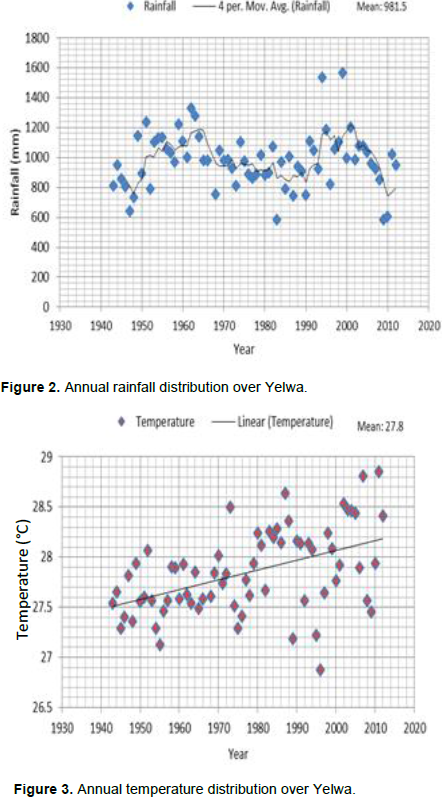

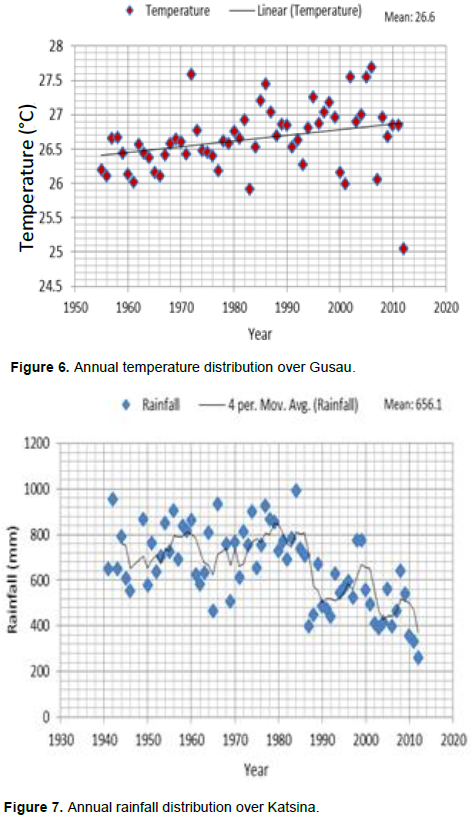
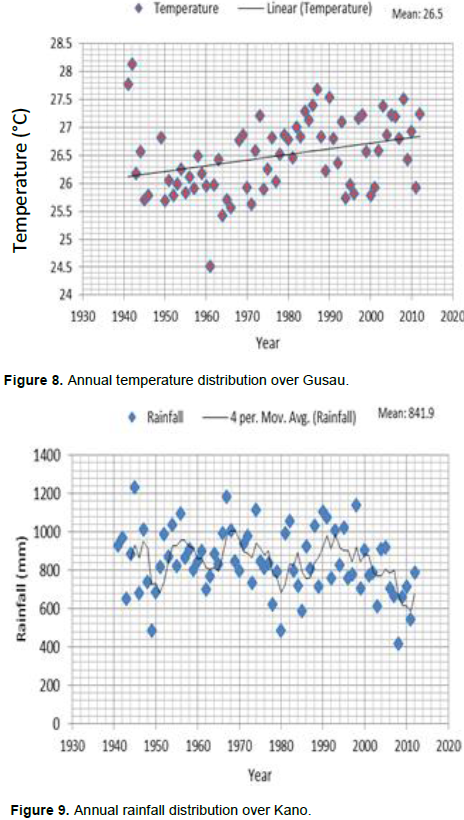
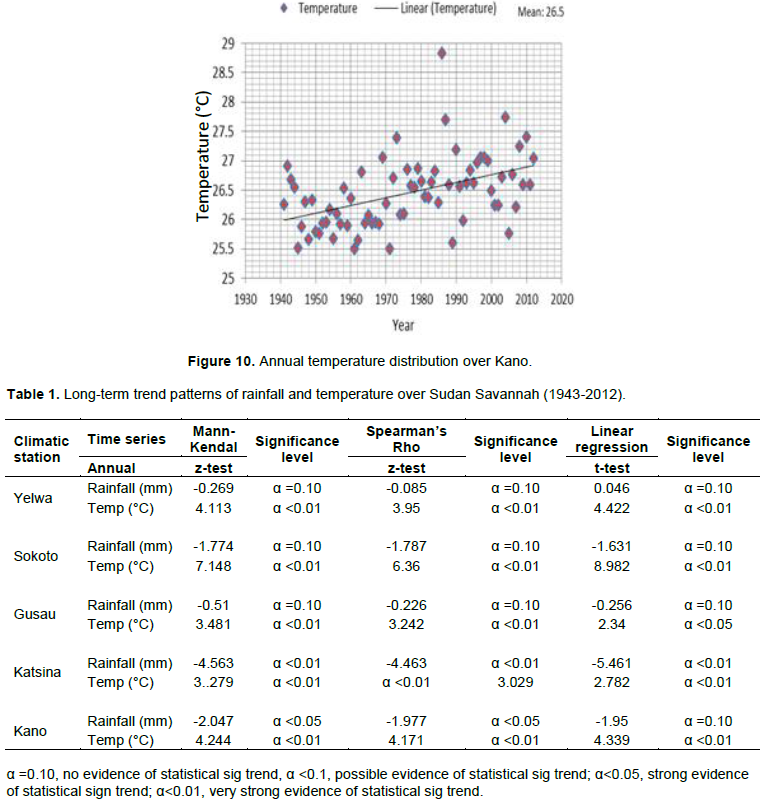
In Table 2, descriptive statistics of long-term annual rainfall and temperature are presented. Rainfall amount decreased from a very high value of 981.5 mm in Yelwa (Lat. 10.88 N; Long. 4.75 E) to a very low value of 656.1 mm in Katsina (Lat. 13.02 N; Long.7.68 E), followed by Sokoto (Lat. 13.02 N; Long. 5.25 E). Kano also recorded a low annual value of 841.9 mm compared to stations in the extreme northwest. This pattern also reveals gradual outward spread of dryness from the Lake Chad basin in the northeast part of the region towards the Sudan savannah, northwest of Nigeria. Mean annual temperature also followed a pattern similar to rainfall. Sokoto recorded the highest temperature in the region in the period under consideration. Coefficient of variation values for Katsina, Sokoto and Kano also confirm that rainfall amounts and temperatures were very erratic in these stations. This observations confirm the report of USAID (2012), that the greatest food insecurity concerns in Nigeria remains in the extreme north, particularly in the northern most parts of Borno, Yobe and Jigawa states in the northeast, and the northern most parts of Kano, Katsina and Sokoto in the northwest. Similarly the National Action Programme to Combat Desertification in Nigeria estimates, about 50 percent and 75 percent of Adamawa, Bauchi, Borno, Gombe, Jigawa, Kano, Katsina, Yobe, Sokoto, and Zamfara states are seriously affected by desertification (Olawumi, 2009).
In Tables 3a-7b, the results of climatic water distributions over the Sudan savannah are presented. It can be seen that with the exception of Kano State, potential evapotranspiration and moisture demand increased during the second climate period (1978-2012) both seasonally and annually. This pattern also corresponds with a general decrease in rainfall and actual evapotranspiration during the first the climate period. In this study, the first climatic period (1945-1979) is considered as stable period before reports of confirmation of increase in world temperature which began in the beginning of the industrial period and an acceleration of warming since late 70s (IPCC, 2013). This period also corresponds with the period of temperature increase in Sahel region which has been traced to the anomalous large-scale sea-surface temperature (SST) warming over the Indian Ocean, tropical Atlantic SSTA, gulf of guinea and the Mediterranean Sea. It started in 1950 and became pronounced in the 1970 and has influenced the climate of Sahel region (Rowell, 2003; Bader and Latif, 2003; Archibong et al., 2007; Obodo, 2008). Thus, rates of deviation were estimated by multiplying the difference in the indices of annual climatic value between the first and second climatic periods, and then dividing the result with annual value of the first climatic period which is considered as stable period. The percentage of deviation in this study is used to denote the extent to which distributions in the second climatic period differed from events in the first climatic period.
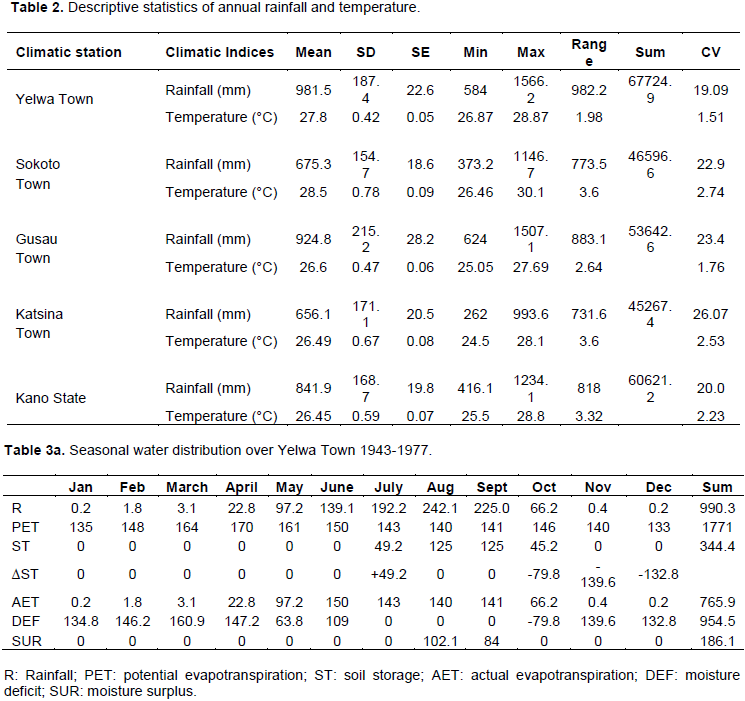
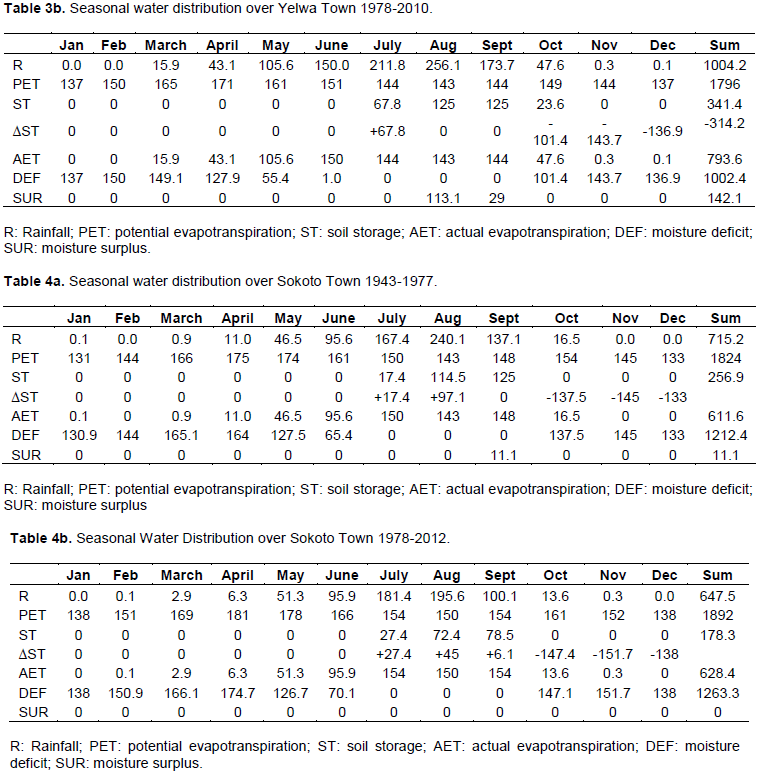
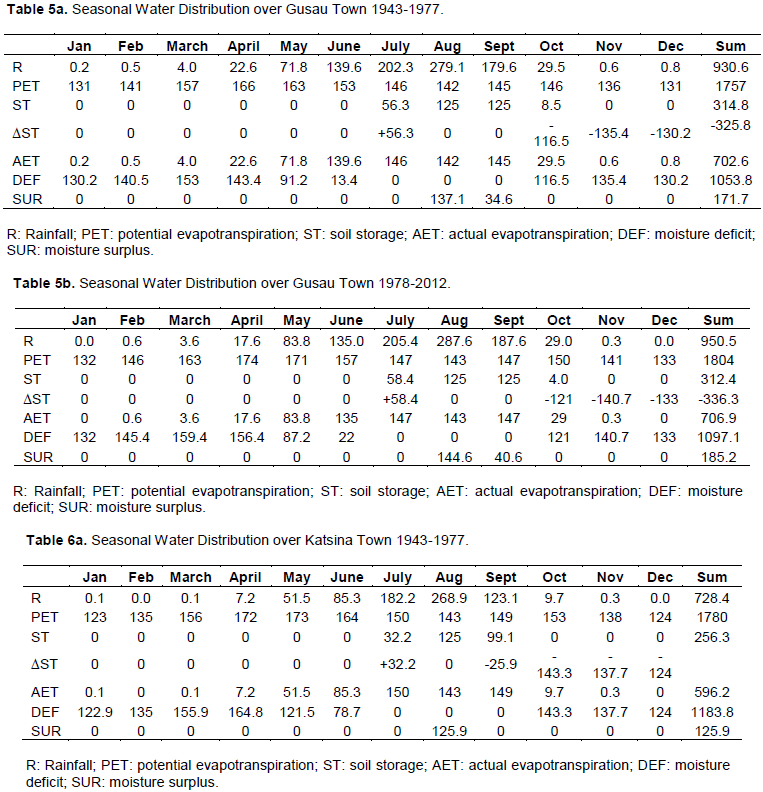
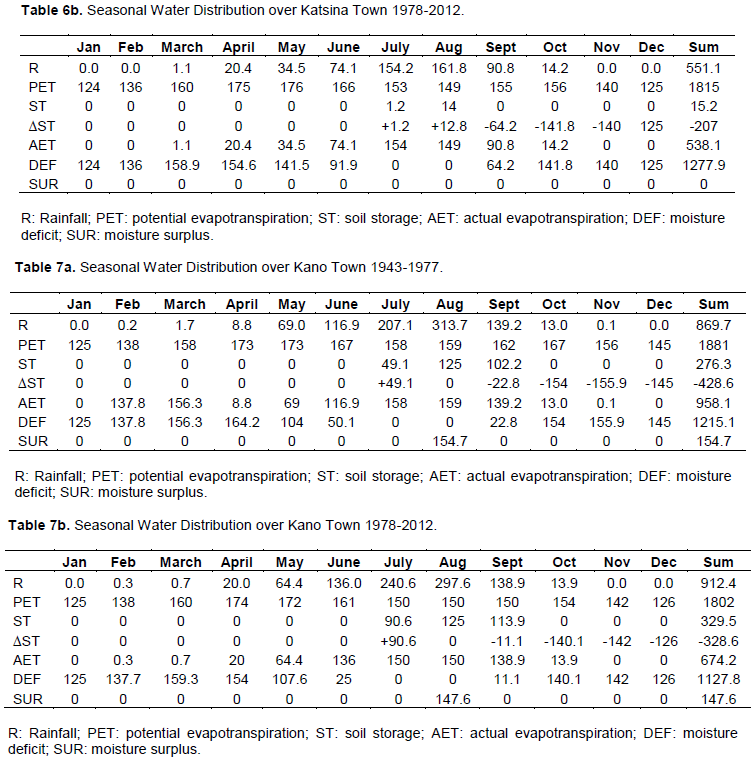
General patterns of deviation in PET from the first climate period were 1.4, 3.7, 2.7, 1.9% for Yelwa, Sokoto, Gusau and Katsina respectively. Deviations in climatic moisture demand (soil moisture deficit) in the second climatic period were 5.0, 4.2, 4.1 and 7.9% for Yelwa, Sokoto, Gusau and Katsina respectively. Moisture storage also decreased in the second climatic period with deviation rates of 0.87, 30.6, 0.76 and 94.1% for Yelwa, Sokoto, Gusau and Katsina respectively. Rainfall was also seen to have decreased in Sokoto and Katsina during the second climatic period with deviation rates of 9.5% (Sokoto) and 24.3% (Katsina).
In Table 8a-d, the difference and rates of deviations in climatic indices are presented. These general observations may suggest that water balance parameters during the second climatic period deviated from patterns observed in the first climatic period (1943-1977). This pattern is further buttressed in Table 9 as moisture index generally showed evidence of decreasing pattern during the second climatic period.
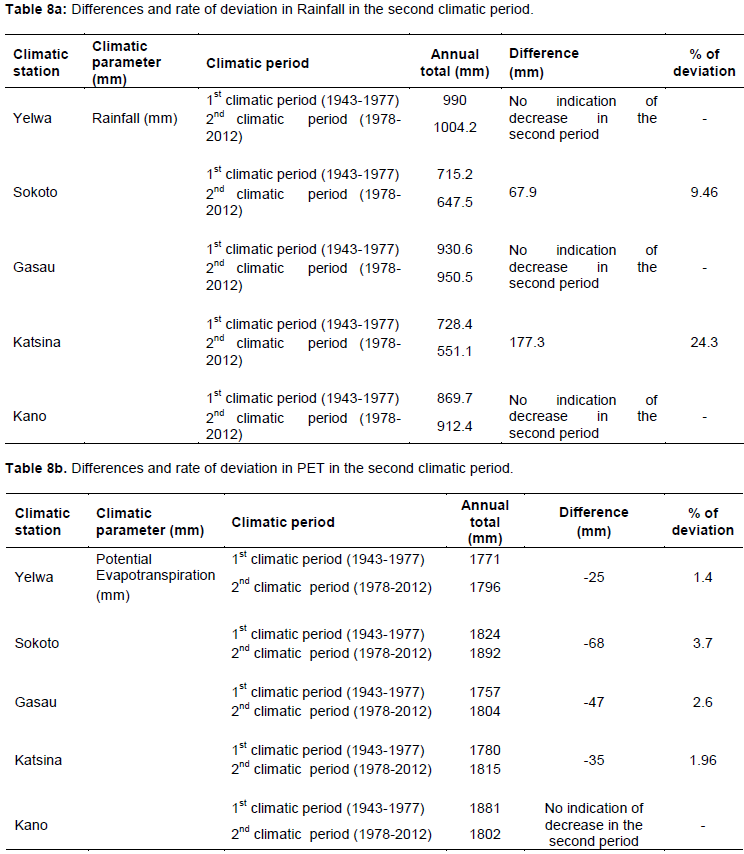
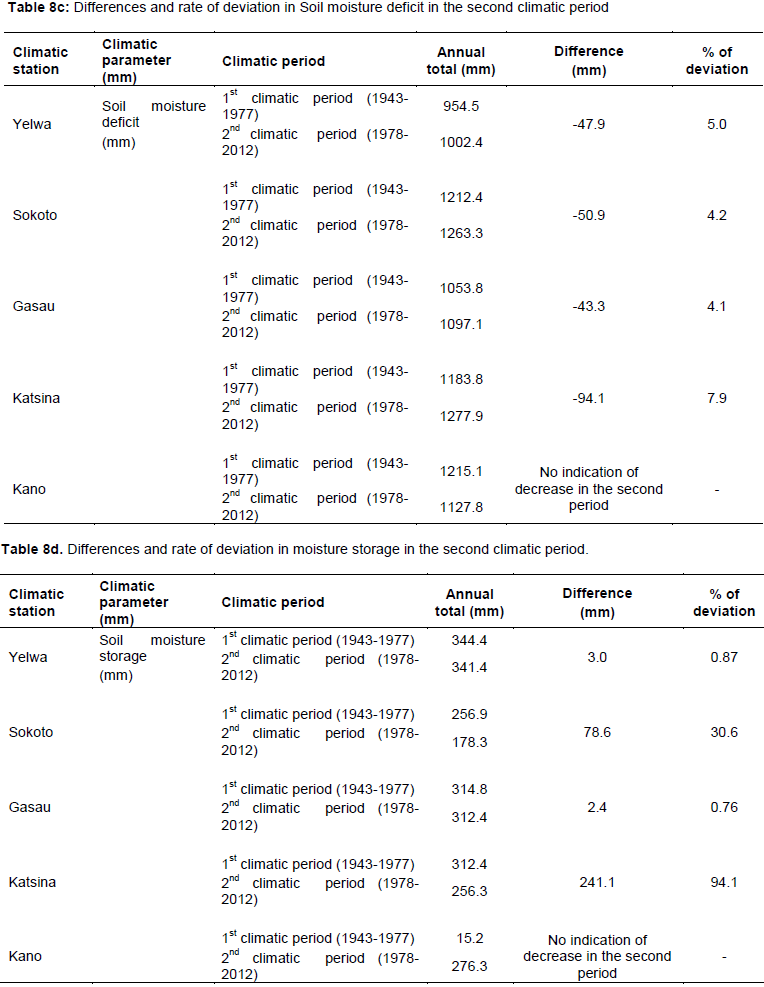

These general patterns of increasing and/or decreasing water balance components are similar to observed statistically significant increases in precipitation and air temperature in the vast majority of the country (Egbinola and Amobichukwu, 2013; Akinsanola and Ogunjobi, 2014; Yaya et al., 2015). The observed evidence of increase in annual time series of temperature, potential evapotranspiration, moisture deficit and declining rainfall pattern in the second climatic period for all the synoptic stations are evidence of changing climate and this conforms with findings from other researchers that since the last century, an increase in average global temperature has been observed, and it is expected to increase further in the future (IPCC, 2001, 2007; Brunetti et al., 2009; Stocker et al., 2013). The intensity and frequency of precipitation are also expected to change, despite the trend differing with the season and the region (Gobiet et al., 2014). This will alter river-flow conditions, and in turn hydropower, which has been investigated from single catchments to a global scale (Schaefli et al., 2007; Koch et al., 2011; Majone et al., 2016). Declining rainfall amount is an important limiting factor for rain-fed crop production which is widely practiced in the study area. The observed decreasing rainfall amount in the extreme northern parts of the basin will exercerbate the ongoing impacts of variability, with serious implications for sustainable socio-economic lives, including decline in agricultural yeilds and farmer-herdmen crises which is already evident in the region. Studies have also linked pests attack and development of crop diseases, witting and desiccation of crops to reducing annual rainfall amount (Thompson and Amos, 2010; Obi, 2010; Aondoakaa, 2012; Singh et al., 2014). For example, Obi (2010) reported evidence of reducing pesticide sensitivity due to decreasing precipitation. His study added that pest population may increase across the northern Nigeria and threaten food production. In a simalr study, NEMA (2010) reported the outbreak of pests and diseases due to meteorological drought condition in part of Borno State, in northern Nigeria.
Evidence of rising temperature has the tendency to trigger hydo-meteorological droughts. As temperature rises, crops will loses water rapidly through transpiration thereby increasing crop water need. High potential evapotranspiration (PET) is usually observed during high temperature conditon (Audu et al., 2013). Thus, higher value of PET, means increased moisture loss, leading to deficit water balance which is unfavourable to crops. Crops growing under low soil moisture, yield little and poor quality seeds. As reported by Obi (2010), while increase in temperature is expected to elongate the growing season in temperate region, such an increase in the tropics will result in decimated agricultural output due to aggravating soil evaporation rate and invariably drought. Increasing temperature weakens plants and their leaves wither easily hence there is poor photosynthesis (Audu et al., 2013). Kim (2009) established that rising temperure will result in reduced crop quantity and quality due to the reduced growth period following high levels of temperature rise; reduced sugar content, bad coloration, and reduced storage stability in fruits; increase of weeds, blights, and harmful insects in agricultural crops; reduced land fertility due to the accelerated decomposition of organic substances. Apart from crops, animals also die in large number during prolonged drought as a result of heat stress, dehydration and attack by drought induced diseases.
CONCLUSION AND RECOMMENDATIONS
The study revealed that rainfall amount decreased from a very high value in the extreme northwest of the Sudan Savannah to a very low value in Katsina. The continuous decrease in rainfall amount in 1940s, 1950 and between 1970 and 1990 could be as a result of reversible climatic fluctuation and not climate change. This is because the 70 years of rainfall data for stations like Yelwa, Sokoto and Gusau revealed little or no evidences of statistically significant downward trends in annual rainfall distribution, but rather repeated drought periods caused by large scale shifts in the general global circulation. Repetition of drought within the present climate regime could be expected and should be planned for. Katsina and Kano however showed strong evidence of trend in rainfall distribution. For temperature, there is strong evidence of increasing trends for all the stations in the region which agrees with the global trend. The deviation in seasonal distribution of water balance components, in general may suggest a proof of changing climatic pattern towards the beginning of the 1980s, a period that coincide with intensified global and regional large-scale sea-surface temperature anomaly (SSTA) which is also reported to have affected the Sahelian climate. The region is gradually been encroached by desert from the extreme northeast. This has implications for socio-economic development of the study area especially coupled with the attendant consequences of increasing population and economic activities in the region. There is thus need to plan for and design sustainable water resources management techniques in different sectors-agriculture, irrigation and dams, water supply to adapt to the quasi-periodic patterns of rainfall fluctuation.
The authors have not declared any conflict of interests.
REFERENCES
|
Archibong OE, Edaefinene LE, Ediang AA (2007). The teleconnection between sea surface temperature analysis from in situ data at East Mole, Lagos and global warming Poster S1.1-4948. 09:15 (S1.1-4947) Plenary.
|
|
|
|
Akinsanola AA, Ogunjobi KO (2014). Analysis of Rainfall and Temperature Variability over Nigeria. Global Journal of Human-Social Science 14(3):1-18.
|
|
|
|
|
Agabi JA (1995). Introduction to the Nigeria Environment.' In Nigerian Environment. National Conservation Foundation. Lagos. Macmillan Nigeria Publishers Limited.
|
|
|
|
|
Amissah-Arthur A, Jagtap SS (1999). Geographic variation in growing season rainfall during three decades in Nigeria using principal component and cluster analyses. Theatrical. Applied. Climatology. 63:107-116.
Crossref
|
|
|
|
|
Aondoakaa SC (2012). Effects of Climate Change on Agricultural Productivity in the Federal Capital Territory (FCT), Abuja, Nigeria Ethiopian Journal of Environmental Studies and Management. 5(4):559-566.
Crossref
|
|
|
|
|
Audu EB, Audu HO, Binbol NL, Gana JN (2013). Climate Change and Its Implication on Agriculture in Nigeria. Abuja Journal of Geography and Development 3(2):8-19.
|
|
|
|
|
Anyadike RNC (1987). The Linacre evaporation formula tested and compared to others in various climates over West-Africa. Agricultural and Forest Meteorology 39:111-119.
Crossref
|
|
|
|
|
Avis CA, Weaver AJ, Meissner KJ (2011). Reduction in areal extent of high-latitude wetlands in response to permafrost thaw. Nature Geoscience 4:444-448.
Crossref
|
|
|
|
|
Ayoade JO (1983). Introduction to Climatology for the Tropics. Spectrum Books Ltd, Ibadan.
|
|
|
|
|
Bader J, Latif M (2003). The impact of decadal-scale Indian Ocean sea surface temperature anomalies on Sahelian rainfall and the North Atlantic Oscillation Geophysical Research Letters 30(22):2169.
Crossref
|
|
|
|
|
Brunetti M, Lentini G, Maugeri M, Nanni, T, Auer I, Böhm R, Schöner W (2009). Climate variability and change in the greater alpine region over the last two centuries based on multi-variable analysis. International Journal of Climatology 29:2197-2225.
Crossref
|
|
|
|
|
Camberlin P, Diop M (2003). Application of daily rainfall principal component analysis to the assessment of the rainy season Characteristics in Senagal. Climate Research 23:159-169.
Crossref
|
|
|
|
|
Dai A, Lamb P, Trenberth KE., Hulme M, Jones PD, Xie P.(2004). The recent Sahel drought is real. International Journal of Climatology 24:1323-1331.
Crossref
|
|
|
|
|
Egbinola CN, Amobichukwu AC (2013). Climate Variation Assessment Based on Rainfall and Temperature in Ibadan, South-Western, Nigeria. Journal of Environment and Earth Science 3(11): 33-45.
Crossref
|
|
|
|
|
Ekpoh IJ, Nsa E (2011). Extreme Climatic Variability in North-western Nigeria: An Analysis of Rainfall Trends and Patterns Journal of Geography and Geology 3:1.
Crossref
|
|
|
|
|
Gobiet A, Kotlarski S, Beniston M, Heinrich G, Rajczak J, Stoffel M (2014). 21st century climate change in the European Alps-A review. Science of Total Environment 493:1138-1151.
Crossref
|
|
|
|
|
Hamon WR (1961). Estimating potential evapotranspiration: Journal of the Hydraulics 87:107-120.
|
|
|
|
|
Ikhatua UJ (2010). Effect of climate change on global and national food security, Paper presented at the 34th Day Celebration of the Nigerian Institute of Food Science and Technology, held at the University of Benin, Benin City, Edo State, Nigeria, Held 5th June, 2010.
|
|
|
|
|
Intergovernmental Panel on Climate Change (IPCC) (2001). Climate Change 2001: Impacts, Vulnerability and Adaptation. Contribution of Working Group III to the Third Assessment Report on the Intergovernmental Panel on Climate Change. Cambridge University Press, Cambridge.
|
|
|
|
|
IPCC (2007). Climate Change (2007). The Scientific Basis, Summary for Policymakers - Contribution of Working Group I to the IPCC Fourth Assessment Report 2007.
|
|
|
|
|
IPCC (2013). The physical science basis. Contribution of working group I to the fifth assessment report of the Intergovernmental Panel on Climate Change; Cambridge University Press: Cambridge, UK and New York, USA 1535 p.
|
|
|
|
|
Jutla AS, Akanda AS, Griffiths JK, Colwell R, Islam S (2011). Warming oceans, phytoplankton, and river discharge: implications for cholera outbreaks. The American Journal of Tropical Medicine and Hygiene 85(2):303-308.
Crossref
|
|
|
|
|
Kalu AE (1987): The recurrence of severe droughts in northern Nigeria. Proceedings of the 1985 Commonwealth Meteorologists Conference. Meteorological Office College, Reading.
|
|
|
|
|
Kamara SI (1986). The origin and types of rainfall in West Africa. Weather 41:48-56
Crossref
|
|
|
|
|
Kim C (2009). Strategies for Implementing Green Growth in Agricultural Sector." in Proceedings in Green Korea 2009 - Green Growth and Cooperation. National Research Council for Economics, Humanities and Social Science.
|
|
|
|
|
Koch F, Prasch M, Bach H, Mauser W, Appel F, Weber M (2011). How will hydroelectric power generation develop under climate change scenarios? A case study in the upper Danube basin. Energies. 4: 1508-1541.
Crossref
|
|
|
|
|
Koutroulis AG, Vrochidou AEK, Tsanis IK (2011). Spatiotemporal characteristics of meteorological drought for the island of Crete. Journal of Hydrometeorology 12:206-226.
Crossref
|
|
|
|
|
Kwak JW, Lee SD, Kim YS, Kim, HS (2013). Return period estimation of droughts using drought variables from standardized precipitation index. Journal of Korean Water Resources. Association .46: 795-805.
Crossref
|
|
|
|
|
Lau N, Nath MJ (2012). 'A model study of heat waves over north America: Meteorological aspects and projections for the twenty-first century', Journal of Climate 25(14):4761-4784.
Crossref
|
|
|
|
|
Lockwood JG (1979). Causes of Climate. New York: Halsted Press, John Wiley and Sons.
|
|
|
|
|
Lyon B (2009). 'Southern Africa Summer drought and heat waves: Observations and coupled model behaviour', Journal of Climate 22(22):6033-6048.
Crossref
|
|
|
|
|
Majone B, Villa F, Deidda R, Bellin A (2016). Impact of climate change and water use policies on hydropower potential in the south-eastern Alpine region. Science of Total Environment 543:965-980.
Crossref
|
|
|
|
|
National Emergency Management Agency (NEMA) (2010). Post Disaster Assessment for Nigeria.
|
|
|
|
|
Nicholson SE (1993). An Overview of African rainfall fluctuations of the last decade'. Monthly Weather Review 111:1646-1654.
Crossref
|
|
|
|
|
Nicholson SE, Tucker, CJ (1998). Desertification, drought, and surface vegetation: an example from the West African Sahel. Bulletin of the American Meteorological Society, 79(5):815-829.
Crossref
|
|
|
|
|
Obi CO (2010). Climate Change and Management of Degraded Soils for Sustainable Crop of Production. Tropical Built Environment Journal Vol. 1.
|
|
|
|
|
Obodo AO. (2008). Chronology of ENSO events and Teleconnection to Nigerian Weather (1978-2005), weather Bulletin.
|
|
|
|
|
Oguntoyinbo JS, Areola OO, Filani M (1983). A Geography of Nigerian Development. Heinemann Educational Books (Nig.) Ltd.
|
|
|
|
|
Olawumi A (2009). Environmental Considerations in Nigerian Agricultural Policies, Strategies, and Programs Nigeria Strategy Support Program (NSSP) Federal Ministry of Environment, Nigeria Report No. NSSP 004.
|
|
|
|
|
Penman HL (1948). Natural evaporation from open water, bare soil and grass. Proceedings of Royal Society A 193:120-45.
Crossref
|
|
|
|
|
Reyburn R, Kim DR, Emch M, Khatib A, von Seidlein L, Ali M (2011). Climate variability and the outbreaks of cholera in Zanzibar, East Africa: a time series analysis. American Journal of Tropical Medical Hygiene 84(6):862-869.
Crossref
|
|
|
|
|
Romero-Lankao P, Smith JB, Davidson DJ, Diffenbaugh NS, Kinney PL, Kirshen P, Kovacs P, Villers LR (2014). North America. In: Climate Change (2014): Impacts, Adaptation, and Vulnerability. Part B: Regional Aspects. Contribution of Working Group II to the Fifth Assessment Report of the Intergovernmental Panel on Climate Change [Barros VR, Field CB, Dokken DJ, Mastrandrea MD, Mach KJ, Bilir TE, Chatterjee M, Ebi KL, Estrada YO, Genova RC, Girma B, Kissel ES, Levy AN, MacCracken S, Mastrandrea PR, White LL (eds.)]. Cambridge University Press, Cambridge, United Kingdom and New York, NY, USA pp. 1439-1498.
|
|
|
|
|
Rowell DP (2003). The impact of Mediterranean SSTs on the Sahelian rainfall season, Journal of Climate 16:849-862.
Crossref
|
|
|
|
|
Schaefli B, Hingray B, Musy A (2007). Climate change and hydropower production in the Swiss Alps: Quantification of potential impacts and related modelling uncertainties. Hydrology of Earth System Science 11:1191-1205.
Crossref
|
|
|
|
|
Singh SK, Singh KM. Singh RK Kumar P, Kumar U (2014). Impact of Rainfall on Agricultural Production in Bihar: A Zone-Wise Analysis.
|
|
|
|
|
Environment and Ecology 32(4A):1571-1576.
|
|
|
|
|
Stocker TF, Qin D, Plattner GK, Tignor M, Allen SK, Boschung J, Nauels A, Xia Y, Bex V, Midgley PM (2013). The Physical Science Basis; IPCC: Cambridge, UK; New York, NY, USA.
|
|
|
|
|
Thompson OA, Amos TT (2010). Climate Change and Food Security in Nigeria. In Journal of Meteorology and Climate Science 8(2): 92-95.
|
|
|
|
|
Thornthwaite CW (1953). The Water Balance of Arid and Semi-Arid climates, in Desert Research. Proceedings, International symposium held in Jerusalem pp. 112-120.
|
|
|
|
|
UNGC (2009). Climate Change and the Global Water Crisis: What Businesses Need to Know and Do? Pacific Institute.
View
|
|
|
|
|
USAID (2012). Famine Early warning systems Network: Nigerian security outlook. View
|
|
|
|
|
Van Asselen S, Verburg PH (2013). Land cover change or landuse intensification: simulating land system change with a globalscale land change model, Global. Change Biology 19:3648-3667.
Crossref
|
|
|
|
|
Vicente-Serrano SM Beguería S, López-Moreno JI (2010). A multiscalar drought index sensitive to global warming: The standardized precipitation evapotranspiration index. Journal of Climate 23:1696-1718.
Crossref
|
|
|
|
|
Westerling AL, Swetnam TW (2003). Interannual to decadal drought and wildfire in the Western United States. EOS 84:545-560.
Crossref
|
|
|
|
|
Whitman E, Batllori E, Parisien MA, Miller C, Coop JD, Krawchuk MA, Chong GW, Haire SL (2015). The climate space of fire regimes in north-western North America. Journal of Biogeography 42(653):1736-1749.
Crossref
|
|
|
|
|
Yaya OS, Gil-Alana LA, Akomolafe AA (2015). Long Memory, Seasonality and Time Trends in the Average Monthly Rainfall in Major Cities of Nigeria. CBN Journal of Applied Statistics 6(2):39-58.
|
|